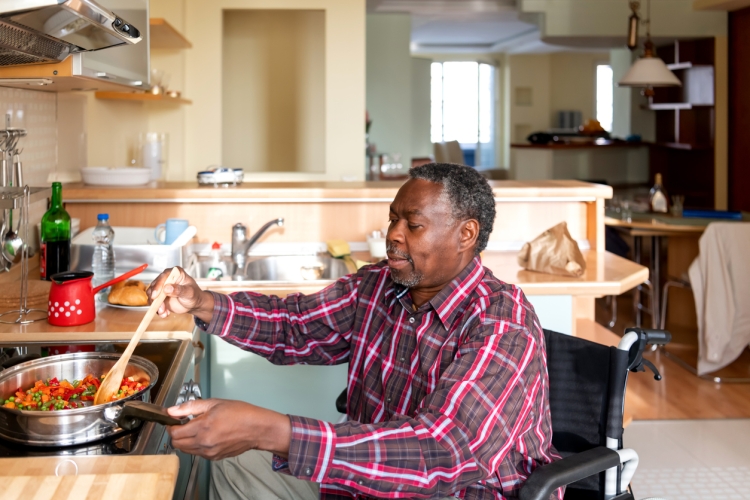Moving ranks in the top five stressors of life for anyone, but when you or a family member has a disability, it can present unique challenges.
Moving with disabilities requires extra considerations, careful planning, and detailed preparation. Fortunately, you can make the transition as smooth as possible by following our helpful tips for an inclusive move.
With this guide, you’ll learn inclusive move strategies and gain valuable insights for making moving easier for people with disabilities. When you understand how to move with a disability from start to finish, you can ensure a successful and stress-free experience for yourself and your loved ones.
Prepare for moving with a disabled person
Whether it’s a physical disability, a chronic illness, or mobility issues, take time before you search for a new residence to plan for the accommodating moving needs for yourself or a loved one with a disability.
- Develop a comprehensive transition plan that outlines the necessary steps, identifies important contacts, and establishes a timeline for each task.
- Start the accommodating moving process well in advance to allow time for arranging additional support, making necessary accessibility adjustments, or securing appropriate equipment.
- Seek expert advice by consulting with professionals experienced in special needs moving, such as occupational therapists or disability service organizations, to help make the move smoother and enhance the overall quality of independent living in your or their new home.
Look into moving assistance programs
Explore resources that provide support specifically tailored for families with disabilities during the moving process, such as applying for grants that can help with adaptions for accessibility.
Also, contact local organizations that provide assistance, resources, and information to individuals with disabilities and their families.
Finally, familiarize yourself with your disability rights and regulations in the new location to ensure the proper accommodations are available and accessible.
Follow these accessible moving tips
Consider the following factors when searching for accessible housing, from a home that is already inclusive to one that can be modified to encourage independent living.
- Assess the overall accessibility of the new home, including entrance ramps, wide doorways, and hallways to accommodate mobility aids such as wheelchairs or walkers. Ideally, the property will have minimal or no steps
- Consider the floor plan and opt for an open universal design that allows for easy maneuverability and unobstructed access to essential rooms
- Evaluate the bathroom to determine if modifications are necessary, such as grab bars, a raised toilet seat, and a roll-in shower or tub with a seat
 Look for kitchen modifications, like lowering countertops, installing accessible cabinets, and evaluating the height and accessibility of necessary appliances
Look for kitchen modifications, like lowering countertops, installing accessible cabinets, and evaluating the height and accessibility of necessary appliances- Determine ways to implement assistive technology through smart home devices
- Prioritize safety by checking for potential hazards like loose carpets, uneven flooring, or inadequate lighting
- Check for smoke alarms, carbon monoxide detectors, and adequate lighting throughout the premises
Hire professional movers with experience in providing inclusive moves
- Choose a moving company experienced in disability accessibility and accommodations.
- Communicate specific requirements, specialized assistance, or accommodations needed during the move, such as packing fragile medical equipment or providing a specific layout in the new home.
Create a moving checklist
To help make moving easier for people with disabilities, a specifically designed checklist can provide structure and support, minimize stress, and ensure a seamless transition to the new living environment.
Use this moving checklist for people with disabilities to ensure that necessary accommodations and accessibility measures are considered.
- Collect medical records and documentation
- Locate healthcare services near you and contact healthcare providers, therapists, and specialists in advance
- Evaluate access to public transportation, medical facilities, or therapy centers
- Secure a new disability parking placard
- Inform your insurance company and evaluate your policies
- Arrange for the setup of utilities such as electricity, water, internet, and cable
- Look into local disability services and organizations that may offer assistance with transportation, home modifications, or counseling services
- Research nearby community resources such as support groups and community centers
- For families with disabled children, contact schools and transfer IEP materials
- Check which disability benefits move with you and which may change if you move out of state or internationally
- Prepare an essentials box to keep with you during the move with a first aid kit, your medications, comfortable clothing, a blanket, personal care items, an emergency contact list, important documents, and necessary assistive devices
Settle into your new home
Consider the potential emotional impact of moving and how it’s affecting your well-being or that of your disabled loved one. When moving with a family with disabilities, help them feel more comfortable and empowered during the move by involving them in decision-making and providing them with opportunities to express their concerns. As they adapt to their new home, create a support system within the new community.
Going forward, remember to regularly review and assess the living arrangements to ensure they are meeting the needs of the disabled person. Make any necessary adjustments or modifications as their needs evolve over time.


